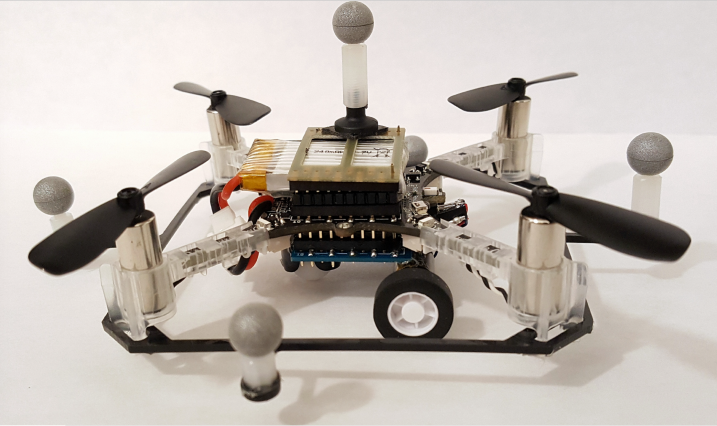MIT's New Drones Can Fly and Drive

As amazing as modern technology is, a lot of it is just struggling to imitate what animals mastered long ago. Birds, for example, can often walk and fly with equal ease. Researchers at MIT's Computer Science and Artificial Intelligence Laboratory (CSAIL) are hoping to build drones that match the agility of airborne drones with the battery life of a land-based drone.
"The ability to both fly and drive is useful in environments with a lot of barriers, since you can fly over ground obstacles and drive under overhead obstacles," says PhD student Brandon Araki, lead author on a paper that presents a system of eight quadcopter drones that can drive and fly through a city-like setting complete with parking spots, no-fly zones, and landing pads. "Normal drones can't maneuver on the ground at all. A drone with wheels is much more mobile while having only a slight reduction in flying time."
The quadcopters build off previous animal-inspired drones Araki has built, including a "flying monkey" robot that crawls, grasps, and flies. However, the flying monkeys couldn't move autonomously. Arkai's team developed "path-planning" algorithms that made sure the drones didn't crash into each other.
The quadcopters have two small motors with wheels on their underside to allow them to drive. In simulations, they could fly almost 300 feet or drive 738 feet before their batteries would run out. Using pieces of felt for roads and avoiding cardboard box buildings, the quadcopters successfully navigated the adorable-sounding fake town set up by CSAIL.
A vehicle with wheels that can fly brings to mind the retro idea of a flying car. But rather than the flying car fantasies of the 50s—basically hot rods with wings—the quadcopters at CSAIL put a premium on size. The ambitions of a flying vehicle incorporated into day-to-day life are starting to turn into reality, with self-driving flying taxis being tested in Dubai later this year.
"As we begin to develop planning and control algorithms for flying cars, we are encouraged by the possibility of creating robots with these capabilities at small scale," says CSAIL direcotr Daniela Rus in a press release. "While there are obviously still big challenges to scaling up to vehicles that could actually transport humans, we are inspired by the potential of a future in which flying cars could offer us fast, traffic-free transportation."
Reference/Source: MIT